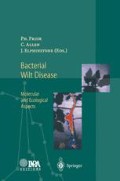Abstract
We used bioluminescent Ralstonia solanacearum YN5 obtained by transforming R. solanacearum OE1-1 with pNP126 carrying the luxCDABE operon of Vibrio fisheri and a promoter region derived from genomic DNA of Burkholderia glumae to observe the behavior of bacteria in tomato plants and the development of bacterial wilt in tomato. Our study demonstrated that the degree of bacterial multiplication in the root and collar after bacterial invasion and the degree of bacterial spread to the upper stem were important factors that determined the susceptibility and the resistance of tomato to bacterial wilt.
Access this chapter
Tax calculation will be finalised at checkout
Purchases are for personal use only
Preview
Unable to display preview. Download preview PDF.
References
Buddenhagen IW, Kelman A (1964) Biological and physiological aspects of bacterial wilt caused by Pseudomonas solanacearum. Annu Rev Phytopathol 2:203 – 230
Date H, Nasu H, Hatamoto M (1993) Thermal death range of Pseudomonas solanacearum under various condition. Ann Phytopathol Soc Jpn 59:709 – 713
Ditta G, Stanfield S, Corbin D, Helinski DR (1980) Broad host range DNA cloning system for gram-negative bacteria: Construction of a gene bank of Rhizobium meliloti. Proc Natl Acad Sci USA 77:7247 – 7351
Enfinger JM, MacCarter SM, Jaworski CA (1979) Evaluation of chemicals and application methods for control of bacterial wilt of tomato transplants. Phytopathology 69:637 – 640
Grimault V, Prior P (1993) Bacterial wilt resistance in tomato associated with torerance of vascular tissues to Pseudomonas solanacearum. Plant Pathology 42:589 – 594
Grimault V, Prior P (1994) Grafting tomato cultivars resistant or susceptible to bacterial wilt: Analysis of resistance mechanisms. J Phytopathology 141:330 – 344
Hara H, Ono K (1983) Ecological studies on the bacterial wilt of tobbaco, caused by Pseudomonas solanacearum EF Smith. IA selective medium for isolation and detection of Pseudomonas solanacearum. Bull Okayama Tob Exp Stn 42:127 – 138
Hayakawa T, Kinoshita K, Miyaki S, Fujiwake H, Ohsuka S (1986) Ultra-low-light level camera for photon counting imaging. photochem. Photobiol 43:95 – 97
Hayward AC (1991) Biology and epidemiology of bacterial wilt caused by Pseudomonas solanacearum. Annu Rev Phytopathol 29:65 – 87
Hikichi Y, Horikoshi M, Okumura A, Hirooka T, Suzuki K (1996a) Relationship between behavior of bioluminescent Pseudomonas cichorii in lettuce and the disease development of bacterial rot of lettuce. Ann Phytopathol Soc Jpn 62:307
Hikichi Y, Nasu Y, Horikoshi M, Okumura A, Toyoda K, Hirooka T, Suzuki K (1996b) Relationship between multiplication of Pseudomonas cichorii in vascular bundle of lettuce leaves and symptom development of bacterial rot of lettuce. Ann Phytopathol Soc Jpn 62:605
Ishikawa R, Fujimoro K, Matsuura K (1996) Antibacterial activity of Validamycin A against Pseudomonas solanacearum and its efficacy against tomato bacterial wilt. Ann Phyotopathol Soc Jpn 62:478 – 482
Kelman A, Sequeria L (1965) Root-to-root spread of Pseudomonas solanacearum. Phytopathology 55:304 – 309
Maly FE, Urwyler A, Rolli HP, Dahinden CA, De Weck AL (1988) A single-photon imaging system for the simultaneous quantitation of luminescent emissions from multiple samples. Anal Biochem 168:462 – 469
Nakaho K, Takaya S, Sumida Y (1996) Conditions that increase latent infection of grafted or non-grafted tomatoes with Pseudomonas solanacearum. Ann Phytopathol Soc Jpn 62:234 – 239
Peregrine WT, Ahmad KB (1982) Grafting -a simple technic for overcoming bacterial wilt in tomato. Trop Pest Man 28 (1):71 – 76
Prior P, Bart S, Leclercq S, Darrasse A, Anais G (1996) Resistance to bacterial wilt in tomato as discerned by spread of Pseudomonas (Burholderia) solanacearum in the stem tissues. Plant Pathology 45:720 – 726
Prosser JI, Killham K, Glover LA, Rattray EAS (1996) Luminescence-based systems for detection of bacteria in the environment. Critical Reviews in Biotechnology 16 157 – 183
Schmit J (1978) Microscopy of early stages of infection by Pseudomonas solanacearum E. F. S. on ‘in vitro’ grown tomato seedlings. In: Proceedings of the 4th International Conference on Plant Pathogenic Bacteria, INRA, Angers, France, pp 841 – 856
Shaw JJ, Kado CI (1986) Development of a Vibrio bioluminescence gene-set to monitor phytopathogenic bacteria during the ongoing disease process in a non-disruptive manner. Bio/Technology 4:560 – 564
Suzuki S, Usa M, Nagoshi T, Kobayashi M, Watanabe N, Watanabe H, Inaba H (1991) Two-dimensional imaging and counting of ultraweak emission patterns from injured plant seedlings. J Photochem Photobiol B: Biol 9:211 – 217
Thurston HD (1976) Resistance to bacterial wilt (Pseudomonas solanacaearum). In: Proceedings of an international planning conference and worksop on the ecology and control of bacterial wilt caused Pseudomonas solanacearum. Sequeria L, Kelman A (eds) Raleigh NC State University, 18 – 23 July 1976, pp 58 – 62
Tikoo SK, Mathal PJ, Kishan R (1979) Successful graft culture of tomato in bacterial wilt sick soils. Current Science 48:259 – 260
Vasse J, Frey P, Trigalet A (1995) Microscopic studies if intercellular infection and protoxylem invasion of tomato roots by Pseudomonas solanacearum. Mol Plant-Microbe Interact 8:241 – 251
Wakimoto S, Uematsu T, Mukoo H (1968) Bacterial canker disease of tomato in Japan. 1. Isolation and identification of the causal bacteria, and resistance of tomato varieties against the disease. Bull Nat Inst Agr Sci Ser C 22:269 – 279
Willetts N, Wilkins B (1984) Processing of plasmid DNA during bacterial conjugation. Microbiol Rev 48:24 – 41
Editor information
Editors and Affiliations
Rights and permissions
Copyright information
© 1998 Springer-Verlag Berlin Heidelberg
About this chapter
Cite this chapter
Hikichi, Y. et al. (1998). Behavior of Bioluminescent Ralstonia solanacearum YN5 Containing the luxCDABE in Tomatoes Susceptible and Resistant to Bacterial Wilt. In: Prior, P., Allen, C., Elphinstone, J. (eds) Bacterial Wilt Disease. Springer, Berlin, Heidelberg. https://doi.org/10.1007/978-3-662-03592-4_34
Download citation
DOI: https://doi.org/10.1007/978-3-662-03592-4_34
Publisher Name: Springer, Berlin, Heidelberg
Print ISBN: 978-3-642-08361-7
Online ISBN: 978-3-662-03592-4
eBook Packages: Springer Book Archive

